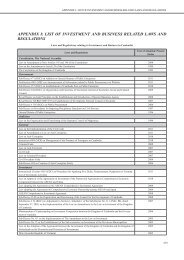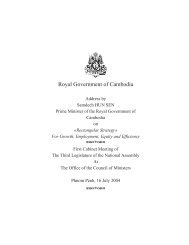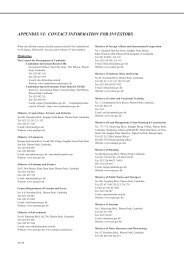Chapter1 - The Council for the Development of Cambodia
Chapter1 - The Council for the Development of Cambodia
Chapter1 - The Council for the Development of Cambodia
Create successful ePaper yourself
Turn your PDF publications into a flip-book with our unique Google optimized e-Paper software.
CAMBODIA<br />
INVESTMENT GUIDEBOOK<br />
January 2012<br />
<strong>Council</strong> <strong>for</strong> <strong>the</strong> <strong>Development</strong> <strong>of</strong> <strong>Cambodia</strong>
A street in Phnom Penh<br />
<strong>The</strong> port <strong>of</strong> Sihanoukville<br />
ii
BUSINESS OPERATING ENVIRONMENT<br />
CONTENTS<br />
MAP OF CAMBODIA ___ i<br />
CONTENTS ___ iii<br />
LIST OF TABLES ___ x<br />
LIST OF FIGURES ___ xii<br />
LIST OF ABBREVIATION ___ xiii<br />
I BASIC INFORMATION ON CAMBODIA ___ I-1<br />
I–1 Geography and Climate ___ I-1<br />
Geography ___ I-1<br />
Climate ___ I-1<br />
I–2 Political System ___ I-1<br />
I–3 Legal System ___ I-1<br />
Legal hierarchy ___ I-1<br />
Legislation process ___ I-1<br />
I–4 International Relations ___ I-2<br />
Foreign Policies ___ I-2<br />
Membership in Major International Organizations ___ I-2<br />
I–5 Social Climate ___ I-2<br />
Population ___ I-2<br />
Ethnic groups ___ I-2<br />
Religion ___ I-2<br />
Language and literacy ___ I-2<br />
Education system ___ I-2<br />
Currency ___ I-3<br />
Public holidays ___ I-3<br />
II<br />
ECONOMIC OVERVIEW OF CAMBODIA ___ II-1<br />
II–1 Economic Situation ___ II-1<br />
GDP ___ II-1<br />
GDP composition ___ II-1<br />
Gross Domestic Expenditures (GDE) ___ II-3<br />
GNI per capita ___ II-3<br />
Consumer Price Index (CPI) ___ II-3<br />
Indices <strong>of</strong> economic freedom ___ II-4<br />
II–2 Investment Trend ___ II-5<br />
FDI trend ___ II-5<br />
Industrial Sub-sector ___ II-6<br />
II–3 Trade ___ II-7<br />
Trade balance ___ II-7<br />
Export trend ___ II-7<br />
Import trend ___ II-7<br />
GSP ___ II-8<br />
iii
III<br />
BUSINESS OPERATING ENVIRONMENT ___ III-1<br />
III–1 Regulatory Framework Relating to <strong>the</strong> Business Operations ___ III-1<br />
III–2 Newly Enacted and/or En<strong>for</strong>ced Regulations ___ III-2<br />
Civil Code ___ III-2<br />
Book Three “REAL RIGHTS” ___ III-3<br />
General Provisions ___ III-3<br />
Ownership ___ III-3<br />
Possessory Rights ___ III-3<br />
Perpetual Leases ___ III-4<br />
Usufruct ___ III-4<br />
Right <strong>of</strong> Use and Right <strong>of</strong> Residence ___ III-4<br />
Easements ___ III-5<br />
Rights created by concession ___ III-5<br />
Book Four “OBLIGATIONS” ___ III-5<br />
General Provisions ___ III-5<br />
Conditions, Time and Period ___ III-5<br />
Formation <strong>of</strong> Contract ___ III-6<br />
Agency ___ III-6<br />
General Rules Concerning Non-Per<strong>for</strong>mance ___ III-6<br />
Specific Per<strong>for</strong>mance ___ III-6<br />
Termination <strong>of</strong> Contract ___ III-6<br />
Burden <strong>of</strong> Risk ___ III-6<br />
Avoidance <strong>of</strong> Fraudulent Act ___ III-7<br />
Extinction <strong>of</strong> Obligation ___ III-7<br />
Assignment <strong>of</strong> Claims ___ III-7<br />
Book Five “PARTICULAR TYPES OF CONTRACTS/TORTS” ___ III-7<br />
Sale ___ III-7<br />
Loans <strong>for</strong> Consumption ___ III-8<br />
Lease ___ III-8<br />
Loan <strong>for</strong> Use ___ III-9<br />
Mandate ___ III-9<br />
Contract <strong>for</strong> Work ___ III-9<br />
Contract <strong>of</strong> Employment ___ III-10<br />
Deposit ___ III-10<br />
Partnership ___ III-10<br />
Compromise ___ III-10<br />
Unjust Enrichment ___ III-11<br />
Torts ___ III-11<br />
Book Six “SECURITY” ___ III-12<br />
General Provisions ___ III-12<br />
Right <strong>of</strong> Retention ___ III-12<br />
Statutory Liens ___ III-12<br />
iv
III–3<br />
III–4<br />
III–5<br />
III–6<br />
III–7<br />
III–8<br />
III–9<br />
Pledge ___ III-13<br />
Hypo<strong>the</strong>c ___ III-13<br />
Transfer as Security ___ III-14<br />
Guaranty ___ III-14<br />
Joint Obligation ___ III-15<br />
Law on <strong>the</strong> Implementation <strong>of</strong> Civil Code ___ III-15<br />
Law on Anti-Corruption ___ III-18<br />
Principles <strong>of</strong> Economic Management ___ III-19<br />
Company ___ III-19<br />
Regulatory framework <strong>for</strong> <strong>the</strong> commercial enterprise ___ III-19<br />
Limited company ___ III-19<br />
Partnership ___ III-20<br />
Foreign business ___ III-20<br />
Trade and Customs ___ III-21<br />
Regulatory framework <strong>for</strong> <strong>the</strong> trading activities ___ III-21<br />
Regulatory framework <strong>for</strong> <strong>the</strong> Customs ___ III-21<br />
Export and import procedures ___ III-23<br />
MFN and GSP ___ III-24<br />
Local contents <strong>for</strong> exports ___ III-25<br />
Incentives, limitations and taxation on exports ___ III-25<br />
Duty-exempted imports (A Master List) ___ III-25<br />
General tariff rates ___ III-25<br />
Preferential tariff rates under <strong>the</strong> AFTA ___ III-25<br />
Free trade agreements <strong>of</strong> ASEAN ___ III-25<br />
AJCEP (ASEAN-Japan Comprehensive Economic Partnership) ___ III-26<br />
Taxation and Accounting ___ III-28<br />
Taxation system ___ III-28<br />
Forms <strong>of</strong> tax and current tax rate ___ III-28<br />
Tax treaty ___ III-28<br />
Accounting principles ___ III-28<br />
Audit <strong>of</strong> corporate account ___ III-28<br />
Bank, Lease, Securities, Insurance and Currency ___ III-30<br />
Banks ___ III-30<br />
Financial lease ___ III-31<br />
Securities market ___ III-32<br />
Insurance ___ III-35<br />
Law on Anti-Money Laundering and Combating <strong>the</strong> Financing Terrorism ___ III-36<br />
Currency ___ III-36<br />
Foreign Exchange ___ III-36<br />
Restriction on <strong>the</strong> <strong>for</strong>eign exchange ___ III-36<br />
Remittance ___ III-36<br />
Employment and Labor ___ III-36<br />
v
III–10<br />
III–11<br />
III–12<br />
III–13<br />
III–14<br />
III–15<br />
III–16<br />
Regulatory framework <strong>for</strong> <strong>the</strong> labor relations ___ III-36<br />
Provisions under <strong>the</strong> Constitution relating to employment in <strong>Cambodia</strong> ___ III-36<br />
Major provisions under <strong>the</strong> Labor Law ___ III-37<br />
Foreign employees ___ III-39<br />
Worker employment in<strong>for</strong>mation ___ III-39<br />
Social Security ___ III-40<br />
Regulatory framework <strong>for</strong> <strong>the</strong> social security scheme ___ III-40<br />
Major provisions on social security schemes ___ III-40<br />
Land ___ III-42<br />
Regulatory framework <strong>for</strong> <strong>the</strong> land system in <strong>Cambodia</strong> ___ III-42<br />
Component <strong>of</strong> a land ___ III-42<br />
Ownership ___ III-42<br />
Acquisition <strong>of</strong> ownership over immovable properties ___ III-43<br />
Effect <strong>of</strong> Real Rights Existing Prior to <strong>the</strong> Date <strong>of</strong> Application <strong>of</strong> Civil Code ___ III-43<br />
Land leases ___ III-43<br />
Mortgage ___ III-43<br />
Land concessions ___ III-43<br />
Economic Land Concession (ELC) ___ III-44<br />
<strong>The</strong> Cadastral Committee ___ III-44<br />
Limitations on land use ___ III-45<br />
Secured Transactions and Insolvency ___ III-45<br />
Secured transaction ___ III-45<br />
Insolvency ___ III-46<br />
Dispute Settlement ___ III-47<br />
Regulatory framework <strong>for</strong> commercial arbitration ___ III-47<br />
National Center <strong>of</strong> Commercial Arbitration (NCCA) ___ III-48<br />
Regulatory framework and procedures <strong>for</strong> labor dispute arbitration ___ III-48<br />
Regulatory framework <strong>for</strong> <strong>the</strong> dispute settlement <strong>of</strong> Qualified Investment Project (QIP) ___ III-48<br />
Environment Protection ___ III-49<br />
Basic policy <strong>for</strong> <strong>the</strong> protection <strong>of</strong> <strong>the</strong> environment ___ III-49<br />
Regulatory framework <strong>for</strong> <strong>the</strong> environmental protection ___ III-49<br />
Standards ___ III-49<br />
Regulatory framework <strong>for</strong> <strong>the</strong> Standards ___ III-49<br />
Major provisions on <strong>the</strong> Standards ___ III-49<br />
Intellectual Property Rights (IPR) ___ III-50<br />
Regulatory framework <strong>for</strong> <strong>the</strong> protection <strong>of</strong> IPR ___ III-50<br />
Trade marks and names ___ III-51<br />
Copyright ___ III-51<br />
Patents, utility model certificates and industrial design ___ III-51<br />
IV<br />
INFRASTRUCTURE ___ IV-1<br />
IV–1 Use, <strong>Development</strong> or Exploitation Concessions ___ IV-1<br />
IV–2 Electricity ___ IV-1<br />
vi
IV–3 Telecommunications ___ IV-3<br />
IV–4 Water Resource ___ IV-5<br />
IV–5 Aviation ___ IV-5<br />
IV–6 Roads ___ IV-7<br />
IV–7 Railways ___ IV-9<br />
IV–8 Sea Port ___ IV-9<br />
IV–9 Inland Water Transportation ___ IV-11<br />
IV–10 Industrial Land ___ IV-12<br />
V INVESTMENT ___ V-1<br />
V–1 Policies toward FDI ___ V-1<br />
V–2 Regulatory Framework <strong>for</strong> Investment ___ V-1<br />
V–3 Outline <strong>of</strong> Investment Approval Scheme ___ V-1<br />
V–4 Responsible Organization ___ V-1<br />
V–5 Qualified Investment Project ___ V-1<br />
V–6 Investment Incentive ___ V-1<br />
Investment incentives granted to a QIP ___ V-1<br />
Projects not eligible <strong>for</strong> <strong>the</strong> incentives ___ V-2<br />
Projects eligible <strong>for</strong> <strong>the</strong> incentives ___ V-2<br />
V–7 Investment Guarantee ___ V-3<br />
V–8 Limitation on Foreign Investment ___ V-3<br />
V–9 Restrictions on Foreign Citizenship ___ V-3<br />
Ownership and use <strong>of</strong> land ___ V-3<br />
Employment <strong>of</strong> <strong>for</strong>eigners ___ V-3<br />
V–10 QIP Approval Procedures ___ V-4<br />
V–11 Incentives entitled to Specific Fields ___ V-4<br />
VI<br />
VII<br />
THE SPECIAL ECONOMIC ZONES ___ VI-1<br />
VI–1 Legal Frame <strong>for</strong> <strong>the</strong> Special Economic Zone (SEZ) Scheme ___ VI-1<br />
VI–2 Basic Concept and Conditions <strong>for</strong> <strong>the</strong> SEZ ___ VI-1<br />
VI–3 Application Process <strong>for</strong> <strong>the</strong> <strong>Development</strong> <strong>of</strong> <strong>the</strong> SEZ ___ VI-1<br />
VI–4 Management Structure <strong>of</strong> <strong>the</strong> SEZ ___ VI-2<br />
VI–5 Procedures <strong>for</strong> Registration <strong>of</strong> <strong>the</strong> Investment Project in <strong>the</strong> SEZ ___ VI-2<br />
VI–6 Incentives (Chapter 4, <strong>the</strong> SEZ Sub-Decree) ___ VI-2<br />
VI–7 O<strong>the</strong>r Regulations ___ VI-3<br />
Rules <strong>for</strong> <strong>the</strong> Export Processing Zone (EPZ) ___ VI-3<br />
Work<strong>for</strong>ce ___ VI-3<br />
Vocational training ___ VI-3<br />
PRIVATE SECTOR IN CAMBODIA ___ VII-1<br />
VII–1 General Situation <strong>of</strong> Private Sector in <strong>Cambodia</strong> ___ VII-1<br />
Number <strong>of</strong> establishments in private sector ___ VII-1<br />
Number <strong>of</strong> establishment by sub-sector ___ VII-1<br />
Number <strong>of</strong> new Establishments ___ VII-1<br />
Street business ___ VII-1<br />
vii
VII–2<br />
VII–3<br />
VII–4<br />
VII–5<br />
Annual sales <strong>of</strong> establishments ___ VII-1<br />
Regional Distribution <strong>of</strong> Private Firms ___ VII-1<br />
Number <strong>of</strong> establishments by province and size <strong>of</strong> employment ___ VII-1<br />
Number <strong>of</strong> establishment per 1,000 persons ___ VII-2<br />
Number <strong>of</strong> establishments per 1,000 households ___ VII-2<br />
Employment by Private Sector ___ VII-3<br />
Number <strong>of</strong> employment ___ VII-3<br />
Employment by sub-sector and new establishments ___ VII-3<br />
Recent Tendency in Manufacturing Sector ___ VII-3<br />
Recent Situation <strong>of</strong> Major Sub-Sectors ___ VII-5<br />
Garment industry ___ VII-5<br />
Footwear industry ___ VII-6<br />
Fabricated metal and electric/electronics products industries ___ VII-7<br />
Food processing industry ___ VII-7<br />
Agricultural, fishery and <strong>for</strong>estry industry ___ VII-8<br />
Natural rubber industry ___ VII-9<br />
Economic Land Concession ___ VII-11<br />
Tourism industry ___ VII-13<br />
VIII MAJOR PROVINCES ___ VIII-1<br />
VIII–1 Explanation <strong>of</strong> <strong>the</strong> Provincial Study ___ VIII-1<br />
VIII–2 Fact Sheets <strong>of</strong> 7 Provinces ___ VIII-1<br />
A. Battangbang Province ___ VIII-1<br />
B. Kampong Cam Province ___ VIII-7<br />
C. Kampot Province ___ VIII-12<br />
D. Kandal Province ___ VIII-18<br />
E. Koh Kong Province ___ VIII-23<br />
F. Preah Sihanouk Province ___ VIII-29<br />
G. Siem Riap Province ___ VIII-34<br />
IX<br />
COST OF DOING BUSINESS ___ IX-1<br />
IX–1 Logistics cost ___ IX-1<br />
For export ___ IX-1<br />
For import ___ IX-1<br />
IX–2 Real estate cost ___ IX-1<br />
Industrial land cost ___ IX-1<br />
Office space cost ___ IX-2<br />
Factory rent/purchasing cost ___ IX-2<br />
Warehouse cost ___ IX-2<br />
IX–3 Manpower cost ___ IX-2<br />
IX–4 Utility cost ___ IX-2<br />
Electricity cost ___ IX-2<br />
Water cost ___ IX-4<br />
viii
IX–5<br />
Gas tariff ___ IX-5<br />
Fuel cost ___ IX-5<br />
Telecommunication cost ___ IX-5<br />
Telephone tariff (Fixed Phone) ___ IX-5<br />
Telephone tariff (Mobile Phone) ___ IX-6<br />
Broadband internet charge ___ IX-7<br />
X LIVING ENVIRONMENT FOR EXPATRIATES ___ X-1<br />
X–1 Housing ___ X-1<br />
X–2 Medical Services ___ X-4<br />
X–3 Education ___ X-5<br />
X–4 Security ___ X-6<br />
REFERENCE : ___ R-1<br />
APPENDIX I : LIST OF INVESTMENT AND BUSINESS RELATED LAWS AND REGULATIONS ___ R-1<br />
APPENDIX II<br />
: LAW ON INVESTMENT ___ AP-8<br />
APPENDIX III : SUB-DECREE NO.111 ON THE IMPLEMENTATION OF THE AMENDMENT TO THE<br />
LAW ON INVESTMENT ___ AP-13<br />
APPENDIX IV : SUB-DECREE NO. 17 ON THE ESTABLISHMENT OF THE SUB-COMMITTEE ON<br />
INVESTMENT OF THE PROVINCES-MUNICIPALITIE ___ AP-30<br />
APPENDIX V<br />
: SUB-DECREE NO. 148 ON THE ESTABLISHMENT AND MANAGEMENT OF THE<br />
SPECIAL ECONOMIC ZONE ___ AP-33<br />
APPENDIX VI : CONTACT INFORMATION FOR INVESTOR ___ AP-44<br />
APPENDIX VII : PUBLIC SERVICES RELATING TO TRADE, INVESTMENT AND SME ___ AP-47<br />
ix
LIST OF TABLES<br />
Table I-3-1 Legal Hierarchy in <strong>Cambodia</strong> ___ I-1<br />
Table I-4-1 Membership <strong>of</strong> Major International Organizations ___ I-2<br />
Table I-5-1 Projected Population in 2011: Top Ten Provinces and National Total ___ I-2<br />
Table I-5-2 Schools, Students, Teaching Staff in <strong>Cambodia</strong> ___ I-3<br />
Table I-5-3 School Enrolment Rate and Completion Rate in 2010 ___ I-3<br />
Table I-5-4 School Attendance by Age Group in 2008 ___ I-3<br />
Table I-5-5 Number <strong>of</strong> Higher Educational Level Students in 2009 and 2010 ___ I-3<br />
Table I-5-6 Public Holidays in <strong>Cambodia</strong> in 2012 ___ I-3<br />
Table II-1-1 GDP Growth Rate by Economic Activity, 2005-2011 ___ II-2<br />
Table II-1-2 Breakdown <strong>of</strong> Industry in GDP, 2005-2011 (Unit: Billion Riel) ___ II-2<br />
Table II-1-3 Composition <strong>of</strong> GDP <strong>of</strong> Selected Sou<strong>the</strong>ast Asian Countries in 2010, Unit: (%) ___ II-2<br />
Table II-2-1 Investments Approved by CDC by Major Countries (1994 – September 2011) ___ II-5<br />
Table II-2-2 Investment Fixed Assets by Source <strong>of</strong> Investment: 1994-September 2011 ___ II-6<br />
Table II-2-3 Investment Approved by CIB by Sector: 1994 – September 2011 ___ II-6<br />
Table II-2-4 CIB-Approved QIPs by Sector in <strong>Cambodia</strong> (1994-2011.9) ___ II-6<br />
Table II-2-5 CIB-Approved Investment Trend by Sector in <strong>Cambodia</strong> (1994-2011.9) ___ II-7<br />
Table II-3-1 Matrix <strong>of</strong> GSP Beneficiaries and Major Markets ___ II-8<br />
Table II-3-2 Number <strong>of</strong> Articles Subject to Preferences under GSP schemes ___ II-8<br />
Table III-1-1 Recently Enacted or Issued Laws and Regulations Relevant to Investment and Business ___ III-1<br />
Table III-5-1 Applicable Rate <strong>of</strong> Import Duties in <strong>Cambodia</strong> (Major Commodities) ___ III-26<br />
Table III-5-2 <strong>Cambodia</strong>’s 2010 CEPT Package <strong>for</strong> Some Commodities ___ III-26<br />
Table III-5-3 Summary <strong>of</strong> ASEAN’s FTAs ___ III-27<br />
Table III-6-1 Tax Scheme <strong>of</strong> <strong>Cambodia</strong> ___ III-29<br />
Table III-6-2 <strong>Cambodia</strong>n Accounting and Auditing Standards ___ III-30<br />
Table III-9-1: Major Vocational Training Centers in <strong>Cambodia</strong> ___ III-39<br />
Table III-9-2: Major Employment Agencies in <strong>Cambodia</strong> ___ III-40<br />
Table III-9-3 Job Announcement Website ___ III-40<br />
Table IV-2-1 Power Demand Forecast (MW) ___ IV-2<br />
Table IV-2-2 Expansion Plan <strong>of</strong> Power Sources ___ IV-2<br />
Table IV-2-3 Expansion Plan <strong>of</strong> Transmission Line ___ IV-3<br />
Table IV-3-1 Telephone Subscribers and Coverage ___ IV-4<br />
Table IV-3-2 Mobile Telephone Service Providers ___ IV-4<br />
Table IV-3-3 Number <strong>of</strong> Client per Postal Station ___ IV-4<br />
Table IV-4-1 Distribution <strong>of</strong> Households by Location <strong>of</strong> Source <strong>of</strong> Drinking Water (2008) ___ IV-5<br />
Table IV-5-1 Present Status <strong>of</strong> Airports in <strong>Cambodia</strong> ___ IV-6<br />
Table IV-5-2 Departure Flights from Phnom Penh International Airport ___ IV-6<br />
Table IV-5-3 Number <strong>of</strong> International and Dom estic Flights (PPIA and SRIA) ___ IV-7<br />
Table IV-5-4 Number <strong>of</strong> Passengers (PPIA) ___ IV-7<br />
Table IV-5-5 Number <strong>of</strong> Passengers (SRIA) ___ IV-7<br />
Table IV-6-1 Length <strong>of</strong> Road Network (as <strong>of</strong> 2009) ___ IV-7<br />
Table IV-6-2 International Roads in <strong>Cambodia</strong> ___ IV-8<br />
Table IV-6-3 Major Road Improvement Projects in <strong>Cambodia</strong> ___ IV-8<br />
Table IV-6-4 Major Bridge Constructions in <strong>Cambodia</strong> ___ IV-8<br />
Table IV-7-1 Situation <strong>of</strong> Railway Facilities ___ IV-9<br />
Table IV-8-1 Berthing Capacity <strong>of</strong> Sihanoukville Port ___ IV-10<br />
x
Table IV-8-2 Cargo Handling Facilities <strong>of</strong> Sihanoukville Port ___ IV-10<br />
Table IV-8-3 Storage Facilities <strong>of</strong> Sihanoukville Port ___ IV-10<br />
Table IV-8-4 Cargo Throughput <strong>of</strong> <strong>the</strong> Sihanoukville Port ___ IV-10<br />
Table IV-8-5 Current Ship Calling Status in Sihanoukville Port ___ IV-11<br />
Table IV-9-1 Maximum Navigable Vessel Size in <strong>the</strong> Mekong River Basin ___ IV-11<br />
Table IV-9-2 Current Situation <strong>of</strong> Phnom Penh Port ___ IV-12<br />
Table IV-10-1 <strong>Cambodia</strong>’s SEZ as <strong>of</strong> <strong>the</strong> end <strong>of</strong> October 2011 ___ IV-13<br />
Table V-6-1 Priority Period ___ V-2<br />
Table V-6-2 Duty-Free Import <strong>for</strong> QIPs ___ V-2<br />
Table V-6-3 Minimum Conditions Required <strong>for</strong> <strong>the</strong> Provision <strong>of</strong> Incentives ___ V-3<br />
Table V-10-1 QIP Application Process V-4<br />
Table V-10-2 Procedures <strong>of</strong> QIP Application and Investment-related Registration/Permits ___ V-5<br />
Table VI-3-1 Application Process <strong>for</strong> <strong>the</strong> SEZ <strong>Development</strong> ___ VI-1<br />
Table VI-6-1 Incentives in <strong>the</strong> SEZ ___ VI-2<br />
Table VII-2-1 Number <strong>of</strong> Establishments, Percent to Total & Size <strong>of</strong> Employee in 2011 ___ VII-2<br />
Table VI-2-2 Number <strong>of</strong> Establishments per 1,000 Persons by Province in 2011 ___ VII-2<br />
Table VII-2-3 Number <strong>of</strong> Establishments per 1,000 Households by Province in 2011 ___ VII-3<br />
Table VII-4-1 Share <strong>of</strong> Manufacturing Sector in GDP at Current Prices (%) ___ VII-3<br />
Table VII-4-2 Number <strong>of</strong> Factories Registered under Ministry <strong>of</strong> Industry, Mines and Energy: 2008 & 2011 ___ VII-4<br />
Table VII-4-3 Number <strong>of</strong> Registered Factories <strong>of</strong> Manufacturing SMEs: 2004-2010 ___ VII-4<br />
Table VII-4-4 Number <strong>of</strong> Employees in Manufacturing SMEs: 2004 - 2010 ___ VII-5<br />
Table VII-4-5 Outputs <strong>of</strong> Manufacturing SMEs: 2004-2010 ___ VII-5<br />
Table VII-5-1 Transition <strong>of</strong> Share <strong>of</strong> Agriculture, Fishery and Forest Sector in GDP (Current Prices) (%) ___ VII-8<br />
Table VII-5-2 Rice Production in <strong>Cambodia</strong> 2006-2010 ___ VII-8<br />
Table VII-5-3 Cultivated Areas <strong>for</strong> Four Main Crops 2006-2010 (Unit: Hectare) ___ VII-8<br />
Table VII-5-4 Livestock and Poultry Production in <strong>Cambodia</strong> 2006-2010 ___ VII-9<br />
Table VII-5-5 Fishery Production from 2006 to 2010 (Metric tons) ___ VII-9<br />
Table VII-5-6 Maintaining and Tapping Area <strong>of</strong> Rubber 2002-2010 ___ VII-10<br />
Table VII-5-7 Tapping Area, Production and Export <strong>of</strong> Rubber 2006-2010 ___ VII-10<br />
Table VII-5-8 Transition <strong>of</strong> Total Rubber Plantation Area 2006-2010 ___ VII-10<br />
Table VII-5-9 <strong>Cambodia</strong> Natural Rubber Plantation Area by Stage in 2010 ___ VII-10<br />
Table VII-5-10 List <strong>of</strong> Economic Land Concessions related to Agro-industry ___ VII-11<br />
Table VII-5-11 Top Ten Source Markets 2009-September 2011 ___ VII-14<br />
Table VII-5-12 Number <strong>of</strong> Business Visitors by Major Country/Region in 2010 ___ VII-14<br />
Table VII-5-13 Number <strong>of</strong> Tourism Services ___ VII-14<br />
Table VII-5-14 CDC-approved Investment Projects in Tourism Industry (2001-2010) ___ VII-14<br />
Table X-1-1 Apartment and Condo Rental ___ X-1<br />
Table X-1-2 Selected Major Hotels ___ X-2<br />
Table X‐2-1 Selected Major Medical Clinics/Hospitals ___ X-4<br />
Table X-3-1 Northbridge International School ___ X-5<br />
Table X‐3-2 International School <strong>of</strong> Phnom Penh ___ X-5<br />
Table X-3-3 iCAN British International School ___ X-5<br />
Table X-3-4 Zaman International School ___ X-6<br />
Table X-3-5 International School <strong>of</strong> Siem Reap ___ X-6<br />
xi
LIST OF FIGURES<br />
Figure I-3-1 Process <strong>of</strong> Legislation by Member <strong>of</strong> National Assembly ___ I-1<br />
Figure I-5-1 Age by Sex Distribution ___ I-2<br />
Figure II-1-1 Trend <strong>of</strong> GDP Annual Growth ___ II-1<br />
Figure II-1-2 GDP Per Capita ___ II-1<br />
Figure II-1-3 Composition <strong>of</strong> GDP by Economic Activity ___ II-1<br />
Figure II-1-4 Composition <strong>of</strong> Gross Domestic Expenditures ___ II-3<br />
Figure II-1-5 Composition <strong>of</strong> Gross Domestic Expenditures ___ II-3<br />
Figure II-1-6 Contribution <strong>of</strong> Components to Changes in Gross Domestic Expenditures at 2000 Market Prices ___ II-3<br />
Figure II-1-7 GNI Per Capita <strong>of</strong> ASEAN ___ II-3<br />
Figure II-1-8 CPI Year on Year Change ___ II-4<br />
Figure II-1-9 CPI All Items from 2008 to 2011(Index: 2006-100) ___ II-4<br />
Figure II-1-10 Scores <strong>of</strong> Ten Economic Freedom Components <strong>of</strong> <strong>Cambodia</strong> ___ II-5<br />
Figure II-2-1 Investment by Leading Countries ___ II-6<br />
Figure II-2-2 Investment Trend by Sector (2006-2011.9) ___ II-6<br />
Figure II-3-1 Trade Balance: 2002 – 2011 ___ II-7<br />
Figure II-3-2 Exports 2006 - 2011 ___ II-7<br />
Figure II-3-3 Imports 2006 - 2011 ___ II-7<br />
Figure III-5-1 Import Procedures ___ III-24<br />
Figure III-5-2 Export Procedures ___ III-24<br />
Figure III-5-3 Procedures <strong>for</strong> Certificate <strong>of</strong> Origin <strong>for</strong> Garment Exports ___ III-25<br />
Figure III-5-4 Comprehensive Tariff Reduction Schedules ___ III-26<br />
Figure IV-10-1 Locations <strong>of</strong> SEZs ___ IV-12<br />
Figure VII-5-1 CDC-approved Investment Projects in Garment (2001-2011) ___ VII-6<br />
Figure VII-5-2 Composition <strong>of</strong> <strong>the</strong> GMAC Member Companies ___ VII-6<br />
Figure VII-5-3 CDC-approved Investment Projects in Footwear (2001-September 2011) ___ VII-6<br />
Figure VII‐5-4 Number <strong>of</strong> International Tourist Arrivals in <strong>Cambodia</strong> ___ VII-13<br />
xii
LIST OF ABBREVIATION<br />
ACCSQ ASEAN Consultative Committee on Standards and Quality<br />
ADB Asian <strong>Development</strong> Bank<br />
AFA ASEAN Federation <strong>of</strong> Accountants<br />
AFTA ASEAN Free Trade Agreement<br />
AII Asian Insurance International<br />
AJCEP ASEAN-Japan Comprehensive Economic Partnership<br />
APO Asian Productivity Organization<br />
BLT Build-Lease-Transfer<br />
BOO Build-Own-Operate<br />
BOOT Build-Own-Operate-Transfer<br />
BOT Build-Own-Transfer<br />
ASEAN Association <strong>of</strong> Sou<strong>the</strong>ast Asian Nations<br />
CAA <strong>Cambodia</strong> Angkor Air Ltd<br />
CAMS <strong>Cambodia</strong> Airport Management Services Ltd.<br />
CAMINCO <strong>Cambodia</strong> Insurance Company<br />
CASs <strong>Cambodia</strong>n Accounting Standards<br />
CC Change in Chapter<br />
CDC <strong>Council</strong> <strong>for</strong> <strong>the</strong> <strong>Development</strong> <strong>of</strong> <strong>Cambodia</strong><br />
CEPT Common Effective Preferential Tariff<br />
CESS <strong>Cambodia</strong> Energy Sector Strategy<br />
CFRSs <strong>Cambodia</strong>n Financial Reporting Standards<br />
CIB <strong>Cambodia</strong>n Investment Board<br />
CJCC <strong>Cambodia</strong>-Japan Cooperation Center<br />
C/O Certificate <strong>of</strong> Origin<br />
C.P. <strong>Cambodia</strong> Post<br />
CPI Consumer Price Index<br />
CPP <strong>Cambodia</strong>n People’s Party<br />
CRC Conditional Registration Certificate<br />
CSA <strong>Cambodia</strong>n Standards on Auditing<br />
CSX <strong>Cambodia</strong> Securities Exchange<br />
CSEZB <strong>Cambodia</strong>n Special Economic Zone Board<br />
CTH Change <strong>of</strong> Tariff Heading<br />
CVI<br />
<strong>Cambodia</strong>-Vietnam Insurance Company Plc.<br />
DPWS Department <strong>of</strong> PoTable Water Supply, MIME<br />
DRHC Department <strong>of</strong> Rural Health Care, MRD<br />
DRWS Department <strong>of</strong> Rural Water Supply, MRD<br />
EAC Electricity Authority <strong>of</strong> <strong>Cambodia</strong><br />
EBA<br />
Everything-But-Arms Initiative<br />
EDC Electricite Du Cambodge<br />
EIA Environmental Impact Assessment<br />
ELC Economic Land Concessions<br />
EMF Export Management Fee<br />
EMS Express Mail Service<br />
EPA Economic Partnership Agreement<br />
EPZ Export Promotion Zone<br />
EU European Union<br />
FAO Food and Agriculture Organization<br />
FDI Foreign Direct Investment<br />
FIU Financial Intelligence Unit<br />
FRC Final Registration Certificate<br />
FTA Free Trade Agreement<br />
GDCE General Department <strong>of</strong> Customs and Excise<br />
GDE Gross Domestic Expenditures<br />
GDP Gross Domestic Product<br />
GMAC Garment Manufacturers Association in <strong>Cambodia</strong>n<br />
GMS Great Mekong Sub-region<br />
GNI Gross National Income<br />
GSP Generalized System <strong>of</strong> Preferences<br />
GVA Gross Value Added<br />
HCMC Ho Chi Minh City<br />
IBRD International Bank <strong>for</strong> Reconstruction and <strong>Development</strong><br />
ICSID International Centre <strong>for</strong> Settlement <strong>of</strong> Investment Disputes<br />
IDA International <strong>Development</strong> Association<br />
IDRC International <strong>Development</strong> Research Center<br />
IEC International Electotechnical Commission<br />
IFC International Finance Corporation<br />
IFDA International Fund <strong>for</strong> Agricultural <strong>Development</strong><br />
IFRS International Financial Reporting Standards<br />
ILO International Labour Organization<br />
IMF International Monetary Fund<br />
IMO International Maritime Organization<br />
INTERPOL International Criminal Police Organization<br />
IPO Initial Public Offering<br />
IPP Independent Power Producers<br />
IPR Intellectual Property Rights<br />
ISC Institute <strong>of</strong> Standards <strong>of</strong> <strong>Cambodia</strong><br />
ISIC United Nations International Standard Industrial Classification<br />
<strong>of</strong> Economic Activities<br />
ISO International Organization <strong>for</strong> Standardization<br />
ITTO International Tropical Timber Organization<br />
ITU International Telecommunication Union<br />
JETRO Japan External Trade Organization<br />
JICA Japan International Cooperation Agency<br />
KHR Khmer Riels<br />
KICPAA Kampuchea Institute <strong>of</strong> Certified Public Accountants and<br />
Auditors<br />
KRX Korea Stock Exchange<br />
Lao PDR Lao People’s Democratic Republic<br />
LDC Least Developed Country<br />
LEPNRM Law on Environment Protection and Natural Resource<br />
Management<br />
MAFF Ministry <strong>of</strong> Agriculture, Forestry and Fisheries<br />
MAI Myanmar Air<br />
MEF Ministry <strong>of</strong> Economy and Finance<br />
MFN Most Favored Nation<br />
MIGA Multilateral Investment Guarantee Agency<br />
MIME Ministry <strong>of</strong> Industry, Mines and Energy<br />
MLMUPC Ministry <strong>of</strong> Land Management, Urban Planning and<br />
Construction<br />
MLVT Ministry <strong>of</strong> Labor and Vocational Training<br />
MOC Ministry <strong>of</strong> Commerce<br />
MOFA Ministry <strong>of</strong> Foreign Affairs<br />
MOWRAM Ministry <strong>of</strong> Water Resources and Meteorology<br />
MPTC Ministry <strong>of</strong> Posts and Telecommunications<br />
MRD Ministry <strong>of</strong> Rural <strong>Development</strong><br />
NAC National Accounting <strong>Council</strong><br />
NBC National Bank <strong>of</strong> <strong>Cambodia</strong><br />
NCCA National Center <strong>of</strong> Commercial Arbitration<br />
NGO Non Government Organization<br />
NIS National Institute <strong>of</strong> Statistics <strong>of</strong> <strong>Cambodia</strong><br />
NL Nor<strong>the</strong>rn Line<br />
NR National Road<br />
NSDP National Strategic <strong>Development</strong> Plan<br />
NSSF National Social Security Fund<br />
PAS Port Authority <strong>of</strong> Sihanoukville<br />
PCA Post Clearance Audit<br />
PMIS Provincial-Municipal Investment Sub-Committee<br />
PPA Power Purchase Agreement<br />
PPIA Phnom Penh International Airport<br />
PSR Product Specific Rule<br />
PPWSA Phnom Penh Water Supply Authority<br />
QIP Qualified Investment Project<br />
REE Rural Electricity Enterprises<br />
REF Rural Electrification Fund<br />
xiii
RGC Royal Government <strong>of</strong> <strong>Cambodia</strong><br />
ROO Rules <strong>of</strong> Origin<br />
RVC Regional Value Content<br />
RWSS Rural Water Supply and Sanitation<br />
SAD Single Administrative Document<br />
SCA Société Concessionnaire des l’Aéroports<br />
SECC Securities and Exchange Commission <strong>of</strong> <strong>Cambodia</strong><br />
SEZ Special Economic Zone<br />
SEZ TSC Special Economic Zones Trouble Shooting Committee<br />
SL Sou<strong>the</strong>rn Line<br />
SMEs Small and Medium Enterprises<br />
SPZ Special Promotion Zone<br />
SRIA Siem Reap International Airport<br />
SRP Sam Rainsy Party<br />
SRWSA Siem Reap Water Supply Authority<br />
SSCA State Secretariat <strong>of</strong> Civil Aviation<br />
TBT Technical Barriers to Trade<br />
UN United Nations<br />
UNCITRAL United Nations Commission on International Trade Law<br />
UNCTAD United Nations Conference on Trade and <strong>Development</strong><br />
UNESCO United Nations Educational, Scientific and Cultural<br />
Organization<br />
UNIDO United Nations Industrial <strong>Development</strong> Organization<br />
UPU Universal Postal Union<br />
US United States<br />
USTR Office <strong>of</strong> <strong>the</strong> United States Trade Representative<br />
VAT Value-added Tax<br />
VNM Value <strong>of</strong> Non-originating Materials<br />
VoIP Voice over Internet Protocol<br />
WB World Bank<br />
WCO World Customs Organization<br />
WHO World Health Organization<br />
WIPO World Intellectual Property Organization<br />
WTO World Trade Organization<br />
xiv
BASIC INFORMATION OF CAMBODIA<br />
I BASIC INFORMATION ON CAMBODIA<br />
I-1 Geography and Climate<br />
Geography<br />
<strong>Cambodia</strong> is situated on <strong>the</strong> southwestern part <strong>of</strong> <strong>the</strong> Indochina<br />
peninsula. It shares a 2,615 km boarder with Vietnam (1,270 km),<br />
Thailand (805 km), and Laos (540 km). Its total area is 181,035 square<br />
kilometers, which is about half <strong>the</strong> area <strong>of</strong> Japan.<br />
Climate<br />
<strong>Cambodia</strong> has a tropical monsoon climate with two seasons: a wet<br />
season from May to October and a dry season from November to May.<br />
<strong>The</strong> annual average temperature is about 27.7 degrees centigrade, and <strong>the</strong><br />
average temperature exceeds 30 degrees centigrade in <strong>the</strong> hottest months,<br />
April and May.<br />
I-2 Political System<br />
<strong>Cambodia</strong> is a constitutional monarchy. <strong>The</strong> present King, His Majesty<br />
Norodom Sihamoni, acceded to <strong>the</strong> throne on 29 October 2004.<br />
<strong>The</strong> Constitution stipulates that <strong>Cambodia</strong> adopts a policy <strong>of</strong> liberal<br />
democracy and pluralism, and that <strong>the</strong> <strong>Cambodia</strong>n people are masters <strong>of</strong> <strong>the</strong><br />
country. <strong>The</strong> Constitution also sets out that <strong>the</strong> power <strong>of</strong> <strong>the</strong> Legislative,<br />
Executive and Judicial branches shall be separated (Article 51).<br />
<strong>The</strong> country has a bicameral legislature, which consists <strong>of</strong> <strong>the</strong> National<br />
Assembly and <strong>the</strong> Senate. <strong>The</strong> latest elections <strong>for</strong> <strong>the</strong> National Assembly<br />
Table I-3-1 Legal Hierarchy in <strong>Cambodia</strong><br />
was held on 27th July 2008 in which <strong>the</strong> <strong>Cambodia</strong>n People’s Party<br />
(CPP) won landslide victory and currently occupied 90seats, followed<br />
by Sam Rainsy Party (SRP), Human Right Party, FUNCINPEC and<br />
Norodom Ranaridh Party which won 26 seats, 3 seats, 2 seats and 2 seats<br />
respectively. <strong>The</strong> Senate held its last election in 2006, through which <strong>the</strong><br />
CPP gained 45 seats, FUNCINPEC 10 seats and SRP 2 seats. Remaining<br />
2 seats are appointed by <strong>the</strong> King. <strong>The</strong> Election <strong>for</strong> <strong>the</strong> Senate members<br />
<strong>of</strong> 3rd legislature will be held on Sunday, 29 January 2012.<br />
Above all, <strong>the</strong> CPP has <strong>for</strong>med <strong>the</strong> Royal Government with FUNCINPEC<br />
Party and Mr. HUN SEN has been elected as <strong>the</strong> PRIME MINISTER OF<br />
THE KINGDOM OF CAMBODIA.<br />
I-3 Legal System<br />
Legal hierarchy<br />
In <strong>the</strong> current legal system in <strong>Cambodia</strong>, <strong>the</strong> hierarchy <strong>of</strong> laws and<br />
regulations is understood as shown in Table I-3-1.<br />
Legislation process<br />
<strong>The</strong> process <strong>of</strong> legislation by a member <strong>of</strong> <strong>the</strong> National Assembly is<br />
shown in <strong>the</strong> flow chart in Figure I-3-1. After <strong>the</strong> adoption by <strong>the</strong> National<br />
Assembly, <strong>the</strong> Senate reviews <strong>the</strong> law, followed by <strong>the</strong> Royal Kram <strong>of</strong> <strong>the</strong><br />
King to promulgate <strong>the</strong> Law.<br />
1) <strong>The</strong> Constitution: <strong>The</strong> Supreme Law <strong>of</strong> <strong>the</strong> Kingdom <strong>of</strong> <strong>Cambodia</strong><br />
2) Treaties and Convention: According to Article 26 <strong>of</strong> <strong>the</strong> Constitution, <strong>the</strong> King shall sign and ratify international treaties both multilateral and<br />
bilateral, and conventions, following <strong>the</strong> approval <strong>of</strong> <strong>the</strong> National Assembly and Senate. After such ratification, international treaties ( both multilateral<br />
and bilateral) and conventions shall become laws and may be used as <strong>the</strong> basis <strong>for</strong> judicial decisions.<br />
3) Laws (Chhbab): Laws adopted by <strong>the</strong> National Assembly<br />
4) Royal Kram (Preah Reach Kram) and Royal Decree (Preah Reach Kret): To be issued under <strong>the</strong> name <strong>of</strong> <strong>the</strong> King <strong>for</strong> executing his<br />
constitutional powers<br />
5) Sub-Decree (Anu-Kret): To be signed by <strong>the</strong> Prime Minister after adoption by <strong>the</strong> Cabinet Meeting. In case <strong>the</strong> sub-decree has not adopted<br />
by <strong>the</strong> Cabinet Meeting, countersignature by <strong>the</strong> Minister(s) in charge shall be required. <strong>The</strong> Prime Minister can use this in exercising his own<br />
regulatory powers.<br />
6) Ministerial Order (Prakas): To be issued by members <strong>of</strong> <strong>the</strong> government in exercising <strong>the</strong>ir own regulatory powers.<br />
7) Decision (Sechkdei Samrech): Individual decision <strong>of</strong> <strong>the</strong> Prime Minister and Decision (Prakas-Deika) <strong>of</strong> a Minister or a Governor, which is<br />
used in exercising his own regulatory powers.<br />
8) Circular (Sarachor): In general, to be issued by <strong>the</strong> Prime Minister as head <strong>of</strong> government, and by a minister as an <strong>of</strong>ficial <strong>of</strong> <strong>the</strong> ministry ei<strong>the</strong>r<br />
to explain or clarify certain legal regulatory measures or to provide instructions.<br />
9) Provincial Deka (Arrete): To be used by a provincial governor within <strong>the</strong> geographical limits <strong>of</strong> his province<br />
Law drafting<br />
Submission <strong>of</strong><br />
draft law to<br />
inter-ministerial<br />
meeting<br />
Decision by <strong>the</strong><br />
Cabinet<br />
Examination<br />
Vote on<br />
adoption<br />
<strong>the</strong><br />
Reviewing Commission<br />
National Assembly<br />
Submission <strong>of</strong> draft law<br />
to <strong>the</strong> Senate<br />
Examination<br />
Vote on <strong>the</strong><br />
ratification<br />
Submission <strong>of</strong><br />
law to <strong>the</strong> King<br />
<strong>for</strong> signature<br />
Senate<br />
Figure I-3-1 Process <strong>of</strong> Legislation by Member <strong>of</strong> National Assembly<br />
I-1
<strong>The</strong> preliminary review will be undertaken by <strong>the</strong> Private Sector Working<br />
Group, <strong>the</strong> Judicial <strong>Council</strong> and <strong>the</strong> Economic, Social and Cultural <strong>Council</strong><br />
be<strong>for</strong>e <strong>the</strong> draft law is sent to Cabinet <strong>for</strong> examination.<br />
I-4 International Relations<br />
Foreign Policies<br />
<strong>The</strong> Constitution declares a policy <strong>of</strong> permanent neutrality and non-alignment<br />
<strong>for</strong> <strong>Cambodia</strong>. <strong>The</strong> Kingdom <strong>of</strong> <strong>Cambodia</strong> follows a policy <strong>of</strong> peaceful<br />
co-existence with its neighbors and with all o<strong>the</strong>r countries throughout<br />
<strong>the</strong> world, shall not invade any country, or interfere in any o<strong>the</strong>r country’s<br />
internal affairs, directly or indirectly, and shall solve all problems peacefully<br />
with due respect <strong>for</strong> mutual interests. <strong>The</strong> Kingdom <strong>of</strong> <strong>Cambodia</strong> shall not<br />
joint in any military alliance or military pact that is incompatible with its<br />
policy <strong>of</strong> neutrality (Article 53).<br />
Membership in Major International Organizations<br />
<strong>Cambodia</strong> joined <strong>the</strong> UN in 1955. After <strong>the</strong> prolonged civil war was<br />
ended in <strong>the</strong> early 1990’s, <strong>the</strong> pace at which <strong>Cambodia</strong> joined various<br />
international economic organizations picked up. Table I-4-1 shows some<br />
<strong>of</strong> <strong>the</strong> <strong>Cambodia</strong>’s membership in international organizations to which<br />
<strong>Cambodia</strong> belongs. In addition, <strong>Cambodia</strong> is also a member <strong>of</strong> FAO,<br />
IMF, Interpol, UNCTAD, UNESCO, UNIDO, WHO, etc.<br />
Table I-5-1 Projected Population in 2011: Top Ten Provinces and<br />
National Total<br />
Rank Province Projected Population in 2011 % to Total Population<br />
1 Kampong Cham 1,745,054 12.0<br />
2 Phnom Penh 1,744,901 12.0<br />
3 Kandal 1,189,955 8.2<br />
4 Battambang 1,126,345 7.8<br />
5 Siem Reap 999,703 6.9<br />
6 Prey Veng 980,667 6.8<br />
7 Takeo 877,839 6.0<br />
8 Kampong Speu 767,827 5.3<br />
9 Banteay Meanchey 745,618 5.1<br />
10 Kampong Thom 668,876 4.6<br />
<strong>Cambodia</strong> Total 14,521,275 100.0<br />
In 2008, Percentage <strong>of</strong> population by age group was as follows.<br />
- Children (0-14 age): 33.7%<br />
- Economically productive age group (15-64): 62%<br />
- <strong>The</strong> elderly population (65+): 4.3%<br />
(Source: General Population Census 2008 1 NIS)<br />
Table I 4-1 Membership <strong>of</strong> Major International Organizations<br />
Organization<br />
Member<br />
Since<br />
Food and Agriculture Organization <strong>of</strong> <strong>the</strong> United Nations 1950<br />
International Telecommunication Union (ITU) 1952<br />
United Nations (UN) 1955<br />
International Criminal Police Organization (INTERPOL) 1956<br />
International Civil Aviation Organization 1956<br />
International Maritime Organization (IMO) 1961<br />
Asian <strong>Development</strong> Bank (ADB) 1966<br />
Universal Postal Union (UPU) 1969<br />
International Bank <strong>for</strong> Reconstruction and <strong>Development</strong> (IBRD) 1970<br />
International <strong>Development</strong> Association (IDA) 1970<br />
International Fund <strong>for</strong> Agricultural <strong>Development</strong> (IFAD) 1992<br />
World Intellectual Property Organization (WIPO) 1995<br />
International Finance Corporation (IFC) 1997<br />
Multilateral Investment Guarantee Agency (MIGA) 1999<br />
Association <strong>of</strong> Sou<strong>the</strong>ast Asian Nations (ASEAN) 1999<br />
International Labour Organization (ILO) 1999*<br />
World Customs Organization (WCO) 2001<br />
World Trade Organization (WTO) 2004<br />
Asian Productivity Organization (APO) 2004<br />
International Centre <strong>for</strong> Settlement <strong>of</strong> Investment Disputes (ICSID) 2005<br />
Asia-Pacific Telecommunity 2007<br />
International Tropical Timber Organization (ITTO) 2009<br />
Note: * <strong>Cambodia</strong> ratified six fundamental conventions <strong>of</strong> <strong>the</strong> ILO in 1999<br />
Source: Ministry <strong>of</strong> Foreign Affairs and International Cooperation<br />
I-5 Social Climate<br />
Population<br />
According to 2008 Population Census, <strong>Cambodia</strong>’s population was 13.4<br />
million with annual growth rate <strong>of</strong> 1.54%. Phnom Penh, <strong>the</strong> capital and <strong>the</strong><br />
largest city, has a population <strong>of</strong> 1.3 million. Percentage <strong>of</strong> urban population<br />
is 19.5% and density <strong>of</strong> population per square kilo meters is 75.<br />
“Report <strong>of</strong> Population Projection <strong>of</strong> <strong>the</strong> 2008 Population Census” projected<br />
<strong>the</strong> national population in 2011 as shown in Table I-5-1.<br />
Source: General Population Census 2008 1 , NIS<br />
Ethnic groups<br />
Figure I-5-1 Age by Sex Distribution<br />
<strong>The</strong> majority are Khmer (90%). Small ethnic groups include Cham,<br />
Vietnamese and Chinese.<br />
Religion<br />
Buddhism is established as a national religion by <strong>the</strong> Constitution<br />
(Article 43, <strong>The</strong> Constitution) and 90% <strong>of</strong> <strong>the</strong> population is Buddhist.<br />
O<strong>the</strong>r religions practiced in <strong>Cambodia</strong> include Islam, Christianity and<br />
o<strong>the</strong>rs.<br />
Language and literacy<br />
<strong>The</strong> <strong>of</strong>ficial language is Khmer. <strong>The</strong> adult Literacy rates in 2008 were 77.6<br />
% in total, 85.1 % <strong>for</strong> males, and 70.9 %<strong>for</strong> females. (Source: General<br />
Population Census 2008, NIS)<br />
Education system<br />
<strong>The</strong> educational system in <strong>Cambodia</strong> consists <strong>of</strong> elementary school (grade<br />
1 to 6), junior high school (grades 7 to 9), senior high school (grades 10 to<br />
12) and university and o<strong>the</strong>r institutions <strong>of</strong> higher education. Compulsory<br />
education is until grade 9.<br />
<strong>The</strong> situation <strong>of</strong> schools at various grades in 2010-2011 is shown in<br />
Table-I-5-2.<br />
Note 1: General Population Census <strong>of</strong> <strong>Cambodia</strong> 2008: National Report on Final Census Results, which was released in September 2009.<br />
I-2
BASIC INFORMATION OF CAMBODIA<br />
Table I-5-2 Schools, Students, Teaching Staff in <strong>Cambodia</strong><br />
# <strong>of</strong> Schools # <strong>of</strong> Classes Enrolment Repeaters Teaching Staff<br />
Pre-school 2,092 3,343 103,315 - 3,549<br />
Primary School 6,767 57,697 2,191,192 158,287 45,408<br />
Lower Secondary (Grade 7-9) 1,573 12,504 560,868 11,818 25,423<br />
Upper Secondary (Grade 10-12) 407 6,786 334,734 5,915 10,057<br />
Source: Education Statistics and Indicators_2010-2011, Ministry <strong>of</strong> Education, Youth and<br />
Sport, <strong>Cambodia</strong><br />
<strong>The</strong> percentages <strong>of</strong> enrollment and completion by education level in 2010<br />
are shown in Table I-5-3.<br />
Table I‐5-3 School Enrollment Rate and Completion Rate in 2010<br />
Education Level Gross Enrollment Rate 2 Net Enrollment Rate 3 Completion Rate 4<br />
Primary school (grade 1 to 6) 116.0 95.2 85.3<br />
Junior high school (grade 7 to 9) 58.5 35.0 46.8<br />
Senior high school (10 to 12) 32.9 20.6 28.5<br />
Source: Educational Statistics & Indicators 2010/2011<br />
Table I-5-5 Number <strong>of</strong> Higher Educational Level Students in 2009<br />
and 2010<br />
2009 2010<br />
Male Female Total Male Female Total<br />
Bachelor<br />
<strong>The</strong> number <strong>of</strong> students 96,769 64,747 161,516 102,310 70,954 173,264<br />
Sex ratio 59.9% 40.1% 100.0% 59.0% 41.0% 100.0%<br />
Master degree<br />
<strong>The</strong> number <strong>of</strong> students 10,545 2,258 12,803 10,544 2,343 12,887<br />
Sex ratio 82.4% 17.6% 100.0% 81.8% 18.2% 100.0%<br />
Doctorates<br />
<strong>The</strong> number <strong>of</strong> students 903 53 956 926 55 981<br />
Sex ratio 94.5% 5.5% 100.0% 94.4% 5.6% 100.0%<br />
Source: Education Congress Report_2010-2011, Ministry <strong>of</strong> Education, Youth and Sport,<br />
<strong>Cambodia</strong><br />
<strong>The</strong> school attendance situation by age group in March 2008 is also shown<br />
in <strong>the</strong> Table I-5-4.<br />
Table I-5-4 School Attendance by Age Group in 2008<br />
Attendance Status Age Group Male Female Total<br />
Source: General Population Census 2008,<br />
NIS: http://celade.cepal.org/khmnis/census/khm2008/<br />
% to Total<br />
Population by Age<br />
Never 5-6 220,596 208,957 429,553 73.1<br />
7 - 12 yrs 142,220 126,264 268,484 14.6<br />
13 - 15 yrs 42,044 38,615 80,659 7.6<br />
16 - 18 yrs 47,134 51,798 98,932 9.9<br />
19-22 yrs 65,973 95,215 161,188 14.4<br />
Now 5-6 yrs 79,924 78,474 158,398 26.9<br />
7 - 12 yrs 796,487 759,211 1,555,698 84.3<br />
13 - 15 yrs 449,000 405,870 854,870 81.0<br />
16 - 18 yrs 281,019 220,812 501,831 50.3<br />
19-22 yrs 146,674 91,897 238,571 21.2<br />
Past 5-6 yrs 0 0 0 0.0<br />
7 - 12 yrs 10,935 9,686 20,621 1.1<br />
13 - 15 yrs 56,119 63,792 119,911 11.4<br />
16 - 18 yrs 182,576 215,044 397,620 39.8<br />
19-22 yrs 342,803 380,598 723,401 64.4<br />
Total 5-6 yrs 300,520 287,431 587,951 100.0<br />
7 - 12 yrs 949,642 895,161 1,844,803 100.0<br />
13 - 15 yrs 547,163 508,277 1,055,440 100.0<br />
16 - 18 yrs 510,729 487,654 998,383 100.0<br />
19-22 yrs 555,450 567,710 1,123,160 100.0<br />
As <strong>for</strong> higher education, <strong>the</strong>re are 91 higher education institutions consisting<br />
<strong>of</strong> 34 public institutions and 57 private institutions in 19 municipalities/<br />
provinces <strong>of</strong> <strong>Cambodia</strong>. 55 <strong>of</strong> <strong>the</strong>m are under <strong>the</strong> Ministry <strong>of</strong> Education,<br />
Youth and Sport Per<strong>for</strong>mance (MoEYS)’s supervision. As can be seen from<br />
<strong>the</strong> Table I-5-5, <strong>the</strong>re are 173,264 bachelor level students in 2010, which<br />
increased by 7.3% comparing to 2009. Both <strong>the</strong> numbers <strong>of</strong> master degree<br />
and doctorates also slightly increased from 2009 to 2010.<br />
Currency<br />
Although <strong>the</strong> <strong>of</strong>ficial national currency is <strong>the</strong> Riel, US dollars are<br />
commonly used in business and commercial transactions.<br />
Public holidays<br />
Public holidays in 2012 are as shown in Table I-5-6.<br />
Table I-5-6 Public Holidays in <strong>Cambodia</strong> in 2012<br />
1 January : International New Year Day<br />
7 January : Victory Day over <strong>the</strong> Genocide Regime<br />
7 February : Meak Bochea Day<br />
8 March : International Women’s Day<br />
14, 15 & 16 April : Khmer New Year<br />
1 May : International Labor Day<br />
5 May : Visak Bochea Day<br />
9 May : Royal Plowing Ceremony<br />
13, 14 & 15 May : King Norodom Sihamoni’s Birthday<br />
1 June : International Children Day<br />
18 June : Queen Norodom Monineath Sihanouk’s<br />
Birthday<br />
24 September : Constitution’s Day<br />
14, 15 & 16 October : Pchum Ben Day<br />
29 October : Coronation’s Day <strong>of</strong> King Norodom Sihamoni,<br />
31 October : Birthday <strong>of</strong> His Majesty King-Fa<strong>the</strong>r Norodom<br />
Sihanouk<br />
9 November : Independence Day<br />
27, 28 & 29 November : Water Festival<br />
10 December : International Human Right Day<br />
Any holiday falling on <strong>the</strong> weekend (Saturday or Sunday) shall move to <strong>the</strong><br />
following day <strong>of</strong> next week. However, if <strong>the</strong> holidays fall on both Saturday<br />
and Sunday, only one day shall be carried over into <strong>the</strong> next week.<br />
Note 2: Gross Enrolment Rate:<strong>The</strong> number <strong>of</strong> pupils or students enrolled in a given level <strong>of</strong> education, regardless <strong>of</strong> age, expressed as a percentage in <strong>the</strong> age group <strong>for</strong><br />
<strong>the</strong> same level <strong>of</strong> education.<br />
Note 3: Net enrolment Rate: <strong>The</strong> number <strong>of</strong> pupils or students in <strong>the</strong> age group <strong>for</strong> <strong>the</strong> given level <strong>of</strong> education enrolled in that level, expressed as a percentage <strong>of</strong> <strong>the</strong> total<br />
population in that age group.<br />
Note 4: Completion Rate to Primary Education: <strong>The</strong> number <strong>of</strong> new pupils in grade 6 in that year, expressed as a percentage in total number <strong>of</strong> population aged 11,<br />
I-3



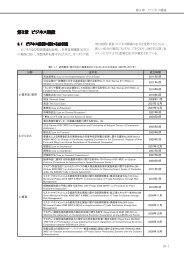

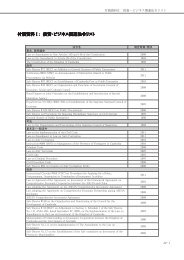
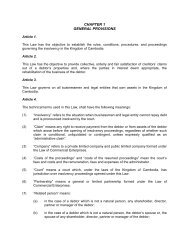



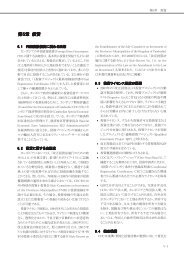
![KHMER-Law on Commercial Rules and Register[of 1995] as ...](https://img.yumpu.com/36645522/1/184x260/khmer-law-on-commercial-rules-and-registerof-1995-as-.jpg?quality=85)
